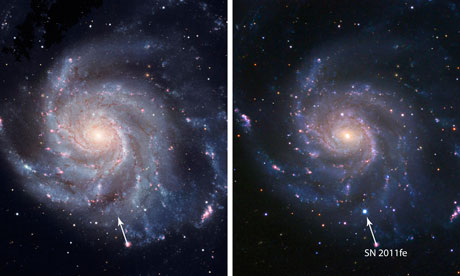The spectacular explosion of a star in a distant galaxy (left, above) has given astronomers a rare glimpse of how supernovae blast the basic ingredients for life into the cosmos.
Scientists captured images of the colossal detonation in the Pinwheel galaxy (right, above) 21m light years away within hours of the burst of light from the explosion reaching Earth.
The supernova, called SN2011fe, was the result of a thermonuclear explosion that tore the parent star apart, converting carbon and oxygen into heavier elements, such as nickel, in the process.
Nasa's Swift space telescope turned its sensors towards the exploding star moments after observations began at three powerful ground-based telescopes. "We caught the supernova just 11 hours after it exploded, so soon that we were later able to calculate the actual moment of the explosion to within 20 minutes," said Peter Nugent at the US department of energy's Berkeley Lab in California.
Watching the star explode gave scientists a unique insight into how elements created in the supernova spewed out into space in the expanding fireball. The telescopes recorded oxygen, magnesium, silicon, calcium and iron being flung out at 16,000 kilometres a second, around 5% of the speed of light.
"Understanding how these giant explosions create and mix materials is important because supernovae are where we get most of the elements that make up the Earth and even our own bodies. For instance, these supernovae are a major source of iron in the universe. So we are all made of bits of exploding stars," said Mark Sullivan at Oxford University.
The observations gave scientists fresh details of what triggers this class of stellar explosion, known as a type 1a supernova. This kind of supernova is important because it always produces the same amount of light. Monitoring their brightness has allowed astronomers to calculate the rate of expansion of the universe.From the results they gathered, the scientists worked out that the explosion began with a white dwarf star made of carbon and oxygen. This kind of star can grow to around 1.4 times the mass of the sun before gravity causes it to collapse in on itself.
"What caused these explosions has divided the astronomical community deeply. SN2011fe is like the Rosetta Stone of Type 1a supernovae," saidShri Kulkarni, a co-author on the study at the California Institute of Technology. The research is published in the journal Nature. Photographs: Press AssociationThe first observations of the supernova were made by the Liverpool Telescope at La Palma in the Canary islands and followed within hours by the Shane Telescope at Lick Observatory in California and the Keck I Telescope on Mauna Kea






